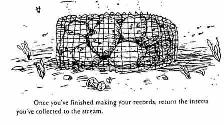
The Streamwatch: A Water Bug Detective Guide
Produced by the Water
Board (
Using water bugs to measure water quality
A stream is usually a home for many different types, of animals, these include insects, crustaceans, molluscs and worms. They are commonly referred to as water bugs. Scientists have found that the number and variety of water bugs found in a stream can give an indication of the relative levels of water pollution. In other words, by sampling the water bugs in your local stream, you can get an idea about the quality of the water!
This Water Bug Detective Field Guide is designed to provide you with information on )low to collect water bugs, make some basic, identifications, and, based on what you've found, work out a Stream Pollution Index for the stream sampled. The higher the Index, the lower the level of pollution, and the healthier the stream.
Collecting Water Bugs
Water bugs live in many different parts of the stream. Some live oil the water's surface. some in the water itself. others on or in the bottom of the river or creek, in the surrounding vegetation, or amongst the rocks. The idea is to sample as many of these different ‘microhabitats’ as possible.
Once you've gathered your equipment, head down to the local stream and try to sample as many of the different stream environments as possible.
Using your net, strain the water at different depths, including the water surface. Run your net over the surface of the bottom, through the plants growing on the water's edge. Wash larger rocks and stones into the net to remove attached animals. Stir the bottom to a depth of two centimetres for two minutes and run your net through the disturbed sediments. Closely examine rocks and plants for bugs and use your tweesers and brush to transfer them to a collecting container. Examine the banks for yabbies and other life. Even look for their homes- yabby holes or caddisfly cases.
An alternative method is to set up an artificial home made of a wire basket (or a nylon mesh bag) containing rocks and debris, and attach it to the bottom of the stream. After four weeks. which should be sufficient time for bugs to colonise the artificial home. remove the basket and wash all the rocks into a small hand net. Remove the water bugs. and transfer them to a collecting container with water.
Sort the water bugs you've collected into their different types, temporarily storing them in separate compartments of the white ice cube tray. Now, using this Guide (look at the pictures), and any of the invertebrate keys you may have, try to make basic identifications of the bugs you've collected. Record what you've found. and, if you want, make drawings of them.
You don't have to identify the water bugs right down to species. Just determine what kind of water bug they are.
Once you've finished making your records, return the insects you've collected to the stream.
Calculating A Stream Pollution Index
The water bugs listed in this guide are split into four groups depending on how sensitive they are to pollution. The links to the groups are:
Each water bug also has a number next to it. When you've completed your collection and identification, add the numbers together and you've got a Stream Pollution Index for (the part of the stream you've sampled. The higher the total, the cleaner the water.)
|
Pollution Index |
Stream Quality Rating |
|
20 or Less |
Poor |
|
21‑35 |
Fair |
|
36‑50 |
Good |
|
51 or more |
Excellent |
Here’s an example of how to calculate a Pollution Index from one set of collection results. Note: if you have two or more morphologically distinct (they look different) organisms from the same group, count them separately.
|
Very Sensitive |
Sensitive |
Tolerant |
Very Tolerant |
|
|
Yabbics (7) |
Dragon Flies(6) |
Leech (3) |
Mosquito(1) |
|
|
May Flies (1) |
Mussels (6) |
Beetles (5) |
Blood Worm(1) |
|
|
Shrimp (6) |
Snails (3) |
|||
| Totals | ||||
| 14+ | 18+ | 11+ | 2 | = 45 |
Polution Index 45 Stream Quality rating: GOOD
Using the Index you can compare your sample site with other sites. You can compare the same site at different times of the year, or with different sites on the same stream, or with different streams.
Keep in mind that the Index is only a rough guide, and its accuracy is very dependant on how well you do your sampling. To make comparisons meaningful, it's important that you use the same sampling technique at each site. It's no good being very thorough at one site, and then not taking the same amount of care at another. It's important that you take the same number of samples, and the same amount of care with each sample.